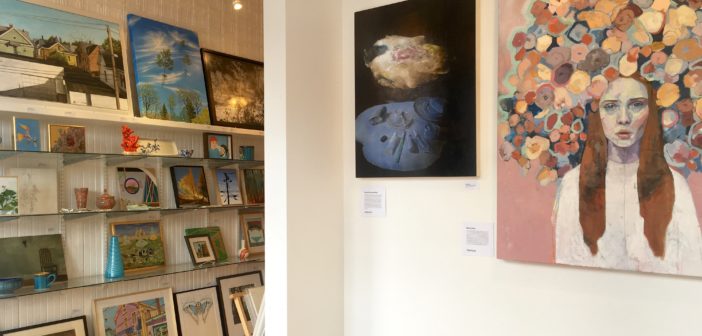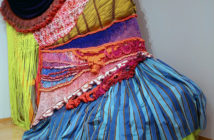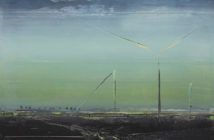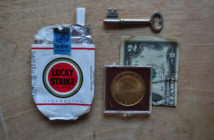Walking along the improved stretch of Mass Ave in Arlington, I saw a couple coming out of the 13FOREST Gallery. They pointed at Mia Cross's painting Agnes and Avi in the front window. They seemed enamored of the sensitive, experimental portrait and talked excitedly about it and other work they'd just seen in the gallery. Inside, I overheard Marc Gurton talking with a guest about the layaway plan they offer. TENFOLD, 13FOREST's ten-year anniversary exhibition, which opened the night before is on view. Gurton said it represents the past, present and future of 13FOREST and its mission: to make art accessible to all.
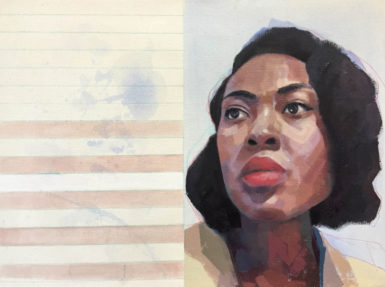
Mia Cross, Agnes and Avi, 2016, oil, acrylic and colored pencil on canvas.
13FOREST’s warm space and inclusive programming prompts thoughtful and spirited exchange among neighbors, artists and patrons. In TENFOLD the curatorial approach highlights a broad range of work that is respectful and skeptical of the history of the region and current social, political and environmental events, suggesting humor and irreverence, making the thinking viewer look, and the looking viewer think. The mastery and broad experience that these artists possess and the rigor of their processes are clearly represented here
I sat down with owners Marc Gurton and Jim Kiely to talk about what Kiely calls this "big, beautiful crazy thing" that they've poured their hearts into for ten years.
Sarah Rushford: Could you talk about how craft and fine art are in dialogue at 13FOREST?
Jim Kiely: When we decided to run with the gallery ten years ago, we talked to experts. The universal advice we got was “You can't run art and craft together. Either be a craft store or an art gallery.” We thought that was silly, even though it was the convention. Artisans are no less passionate and no less disciplined than a painter or sculptor. We didn't see that there was a difference between them. We decided to ignore that entire model and run it all together. It's led to a non-hierarchical model that respects the work of those who work with their hands. Keeping art accessible, which is our mission, I think is a big part of the success of it.
Marc Gurton: I also think that’s the key to accessibility. It’s hard to get the average person to trust her/his own taste. Combining craft and art ultimately demystifies the art buying process. That’s the most important thing. It’s also important for us to meet the artists whose work we collect so that we can develop a real connection to them, and to the art.
SR: Marc, you have a practical approach. You often foreground printmaking because it's an affordable way for your customer to start a collection, for example, and you offer a layaway plan.
MG: Some of our clients are people with two or three jobs, or are trying to put their kids through school. Many people buy work on layaway. And buying a print is a great way to start a collection.
JK: When an artist brings his or her works into a gallery there's a huge amount of trust that has to be established. We have a very simpatico relationship with everyone whose work is here. It's very transparent. When customers come in they often want to know about the artist: what they do, if they’ve shown, and biographical and personality information. Having a solid relationship with the artists enables us to answer their questions. I'm the same way, when I'm buying something I want to know about the artist because I want to know what the vibe is of the work that's coming into my home.
SR: It seems like this model builds a strong art community among you, your artist clients, and your patrons. It’s very supportive.
JK: A big part of what we do, and Marc touched on this too, is that we try to demystify the process of looking closely at an object and establishing a relationship to it. We spend a lot of time trying to make people comfortable with their own taste. People become repeat customers knowing they're not going to get hassled and that there's no wrong decision to be made. They end up with more confidence.
SR: Can you talk more about your experience with art growing up?
MG: First of all, my mom was an artist. She went to the BU College of Fine Arts and she taught art when she was carrying me. When I was a kid she got her Master's Degree in Education. I remember going to the Brooklyn Museum with her. And my grandmother always had exquisite taste. Then I went to Brandeis and took a full year of art history as a freshman. It was an amazing class because each expert taught one section. There were seven professors over the course of two semesters. I loved that class. Later I studied accounting, also at BU, and I was an accountant for twenty years. Once we had the gallery I thought again about the art history class and how much I loved it.
Before we started the gallery we went to a career counselor. She asked us about our family history, and I realized I had all these salesmen in my family. My dad was an insurance salesman, and my grandfather was a great salesman. He was a bra salesman. You know Bali bras? As it happens my Aunt Sarah and Uncle Sam started that company. Even my great-grandfather was a salesman.
JK: I've always had a very strong appreciation and curiosity for art. I grew up in a small town in Maine. In our public school, there was a real art class and a real art teacher and I was encouraged to pursue art. I could draw well. I also took art classes outside of school. We had a little historical museum in our town, and we were encouraged to go to museums to look at things, investigate them, and discover art and artifacts that meant something. That had a big impact on how I studied when I was in college. I majored in art history, and I also worked as a muralist.
SR: Is there evidence of this investigative, art historical approach in the collection?
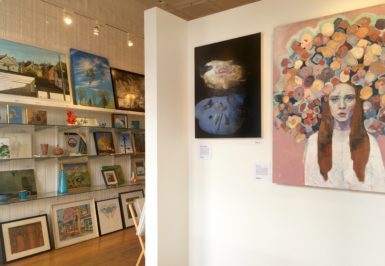
13Forest with works by Nicole Duennebier and Mia Cross in TENFOLD.
JK: Yes. I think with this piece here (gestures to John Campbell's Theater). It [Theater] is a faux history. There are all kinds of different icons sewn together into a single landscape. Or, Nicole Duennebier’s paintings [are another example]. I see Dutch painting in them and also twentieth and twenty-first-century sciences. Wilhelm Neusser intentionally takes strands from German art history and clichés in German art and pulls them together sometimes in a joking way and sometimes in a beautiful, serious way.
SR: Humor is another trope through which to view your collection.
MG and JK: Yes. we have a lot of witty pieces ( gestures towards Jack O’Hearn’s Siamese #1 that depicts a Siamese pipe connection painted hyper-realistically, where the artist is taking a really mundane thing and elevating it into a great icon). And of course Mark Luiggi, Daniel Benayun, Coco Berkman (bantering) are all artists in our collection whose work uses humor, and there are more. In fact, one of the first things we ever bought was a Kahn & Selesnick print–a very whimsical faux-history piece. CJ Lori’s Just the Two of Us (a painting depicting a forest with several of the trees flying into the sky) is a play on Surrealism, for example.
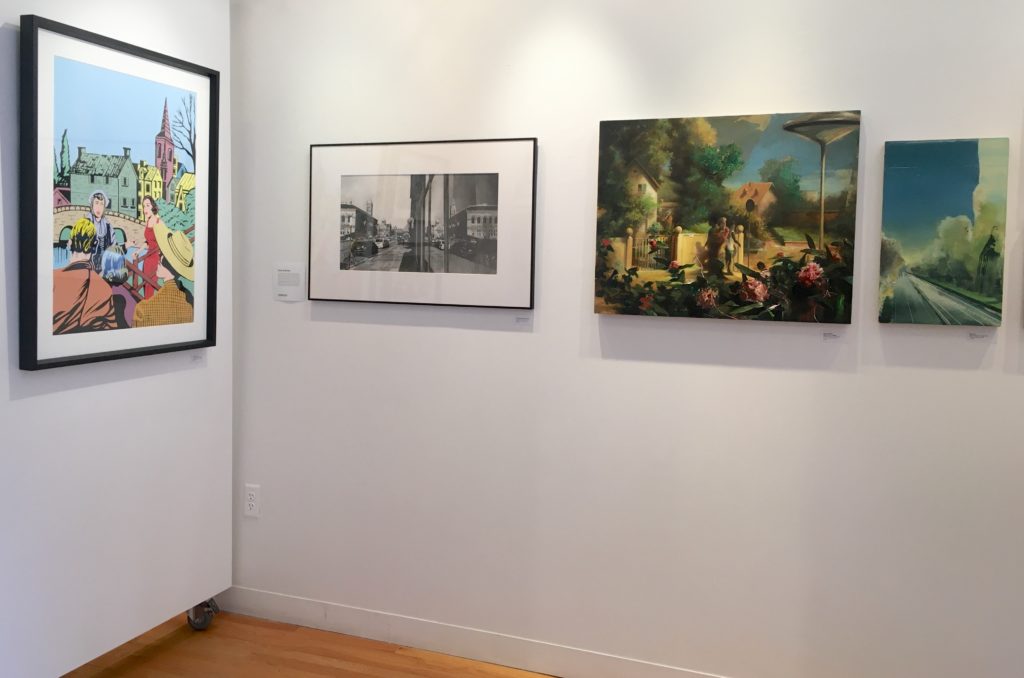
Works by Daniel Benayun, Kate Sullivan, and Wilhelm Neusser in TENFOLD.
SR: When I walk in here I have the sense that I have my finger on the pulse of the art world. Do you represent the region’s work as a whole? Do you work with artists from the New York area too?
JK: It's funny that you bring up New York. I've always been bothered by people saying that the art in New York is better than the art in Boston. It's not; there's just more of it. If I could spell out one thing it's that the Boston area produces world-class art, and some of it will languish in obscurity and some of it is right in front of your face. What makes me the most proud of owning a gallery is that I'm able to incrementally demonstrate that.
SR: What kinds of changes are coming in 13FOREST's future ?
MG: We are in the middle of an exciting rebranding project. Josh Luke from Best-Dressed Signs designed and hand-painted the new building numbers and we're working with Nina Wishnok to update our visual identity.
SR: Can you talk more about how you discovered your newest artist Mia Cross, whose work is in TENFOLD?
MG: Jillian Wertheim, the gallery director, and I met her when she was in a show at the Arsenal Center for the Arts. We actually met her and her parents. It was a very organic way to meet. I said to Jillian, “We should pay attention to this work.”
SR: So that's an important part of your work, to be part of the community and discover artwork this way?
MG: Yes, definitely. When we first started I went to all these craft shows. With craft shows, let’s face it, you have to kiss a lot of frogs. . .but I love going to them because you never know when there's going to be some artist who probably is working several jobs, but can occasionally manage to get some things out there, and you're like, “This work is amazing!”
SR: You have confidence in your taste, and the unconventional approach of pairing art with craft is bold, unapologetic. Is that a transformative thing for you?
MG: After ten years, yes. But I'll say to Jim, “Am I crazy, what about this?” I rely on Jim and Jillian, and we have a lot of conversations. I like to get the input from them, but sometimes I just have to say, “You know, not that one.” If the stuff is on my walls, I have to be able to stand by it.

